
Background
The Geffrye Museum in Shoreditch, East London, is the only museum in the United Kingdom to specialise in the history of the domestic interiors of the urban middle classes. It is situated in the centre of the old furniture and cabinet-making area of London and it displays a collection of English furniture and decorative arts from 1600 to the present day in a series of period room settings. The Museum is housed within fourteen former almshouses, which were built in 1715 and are Grade 1 listed. A chapel forms the central element of the Museum.
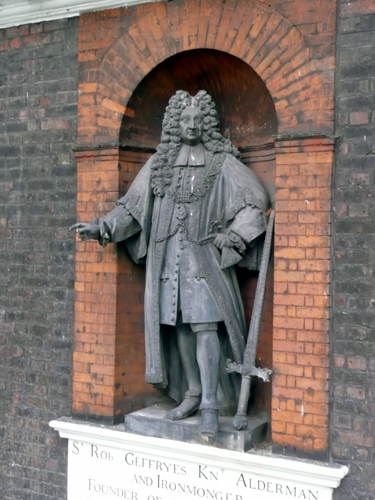
The Museum takes its name from Sir Robert Geffrye (1613-1704), who was Lord Mayor of London in 1685. On his death he bequeathed the residue of his estate to the Ironmongers’ Company for the purchase of land and the construction of almshouses mainly for ironmongers’ widows. The converted almshouses first opened to the public as a museum in 1914 under the direction of the London County Council.
Ten years ago the Museum doubled in size with the opening of a new extension, which provided a new gallery for 20th century period rooms, a temporary exhibition gallery and new education facilities, as well as a restaurant and expanded bookshop. A special gallery shows contemporary design and craft by East London designer-makers. The rear gardens were laid out as a series of garden rooms showing the development of town gardens since the 17th century.
Patrick Baty and Papers and Paints have had a long history of working with the Geffrye Museum, either supplying paint or providing advice on paint colour for the period room display. In 2002 we assisted with the restoration of one of the historic almshouses to show the conditions in which the alms people lived in the 18th and 19th centuries. In 2004 Patrick helped with the interpretation of the paintings that were displayed in their very successful series of exhibitions devoted to “Home and Garden”. A very informative catalogue was published to accompany this exercise.
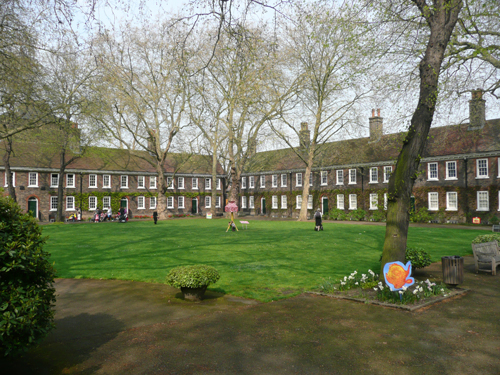
Our latest project at the Geffrye Museum is an analytical one. We have been asked to examine and report on the paint colours that have been applied to the external surfaces of the fourteen almshouses and central chapel. The surfaces include the cornice, windows, rainwater goods, doors and railings, both front and back.
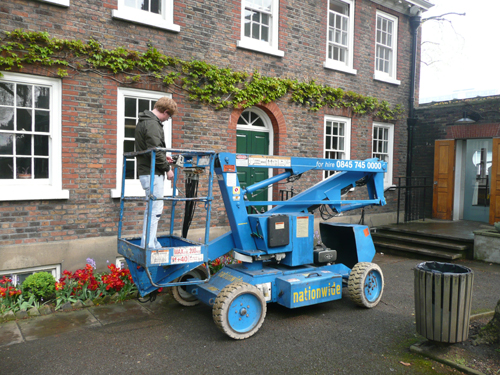
Fortunately I had the use of a cherry-picker in order to reach the higher levels. Clearly the Museum must have heard of my cherry-picker driving skills from a previous client (Fulham Palace) and had persuaded one of their gardeners to help me. Jamie turned out to be a real asset, being able to manoeuvre the vehicle through the tightest gaps and get us within reach of every surface that I wanted to sample.
With only a brief stop for coffee and a sandwich we worked our way around the front of the Museum chipping, drilling and cutting samples from elements of each of the buildings.
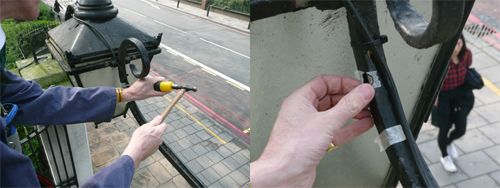
As mentioned in my short account of sampling on Tower Bridge (see blog 20th March), ironwork when hit at the right angle usually yields its secrets. This can be seen in these images of the overthrow above the main gate. It is too early to be able to report on what I found on the ironwork at the Geffrye Museum as the samples are still being processed, but the following image from a project at the Welsh Office (Gwydyr House), in Whitehall, shows what one might expect from the railings.
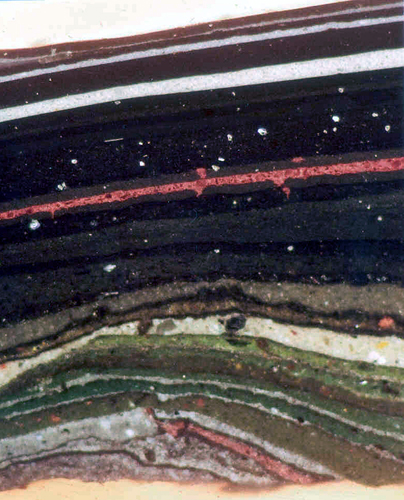
External woodwork, on the other hand, especially of this antiquity is more difficult. Using a dental drill to mark out a small square, which is then undercut with a sharp craft knife, a tiny plug can removed. The aim is to take a piece of the substrate (wood) with all the overlying layers of paint in one piece. This is seldom possible when dealing with thirty odd layers of brittle paint.
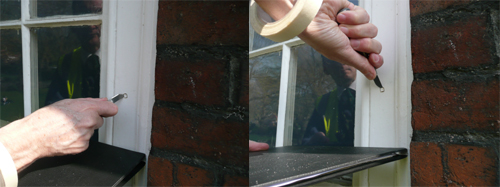
Once again, I am still working on the samples, but the following sample taken from a door belonging to Benjamin Franklin’s house, in Craven Street, shows what to expect on 18th century woodwork.

Simplistically, in order to get an idea of how frequently an external surface has been painted, one can divide the age of the building by the number of painted schemes. This will only work if all layers have survived. Samples taken from later elements can also help provide a datum, which is why this Victorian letterplate was sampled.
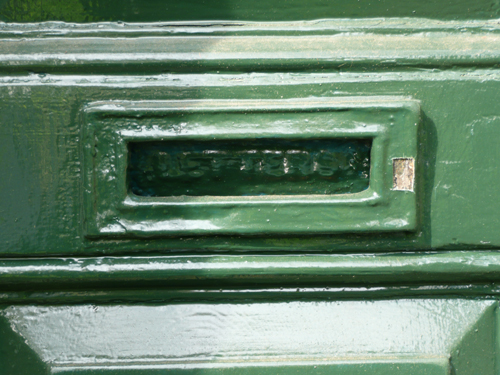
Clearly, bearing in mind the aim of the Museum, there is a wish to paint the exterior in a scheme that relates to one of its earlier ones. Once I have finished the paint analysis the report that I will produce will show them how the almshouses appeared throughout their long history.
One thing is certain; the railings were not black originally.
The findings of the analysis were written up in later blog post.
With thanks to everyone at the Museum for their cooperation and to Jamie, in particular.
The Geffrye Museum, 136 Kingsland Road, Shoreditch, London E2 8EA. Tel. 020 7739 9893.
Admission: Free
Tel. +44 (0)20-7352-8626
Click for more information on what I do.
[ipaper id=12102749]
[ipaper id=22905837]












No comments yet. Be the first!